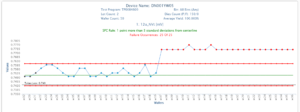Semiconductor Statistical Process Control (SPC) is a method of quality control using statistical techniques. SPC seeks to separate normal or systematic variations from unusual or special variations. These techniques are usually applied to yields or specific test results at each process step in semiconductor manufacturing. The primary benefit is to achieve early warning of issues before producing a lot of potentially bad material.

SPC is a two-step process. The first step is to measure normal variations and using the data to calculate a Process Capability Index (Cpk). The second step includes continuous monitoring of production material via control charts and calculating that the material doesn’t violate a pre-defined set of rules. Common sets of rules such as Western Electric, Wheeler and Nelson are well known although many semiconductor companies build their own customized SPC rules. Material is considered “in-control” when it adheres to these rules and “out-of-control” when it does not.
When SPC rules detect an out-of-control signal, then some combination of alerts and/or interruption of production flows is commonly employed. yieldWerx Enterprise’s semiconductor SPC software module allows you to create product- and test-specific rules that monitor and automatically generate email alerts and/or send stop notices to equipment and MES systems.